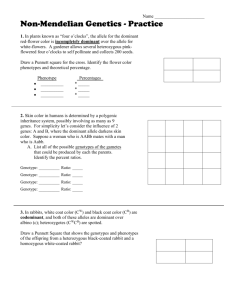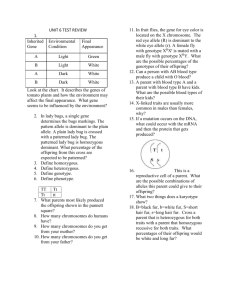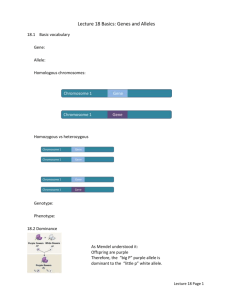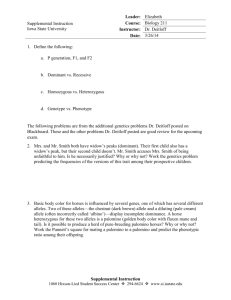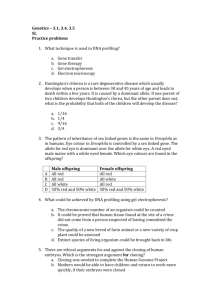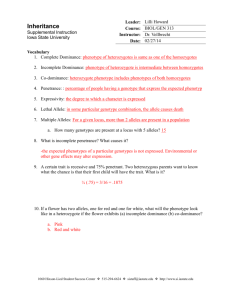Solutions to Incomplete Dominance
advertisement
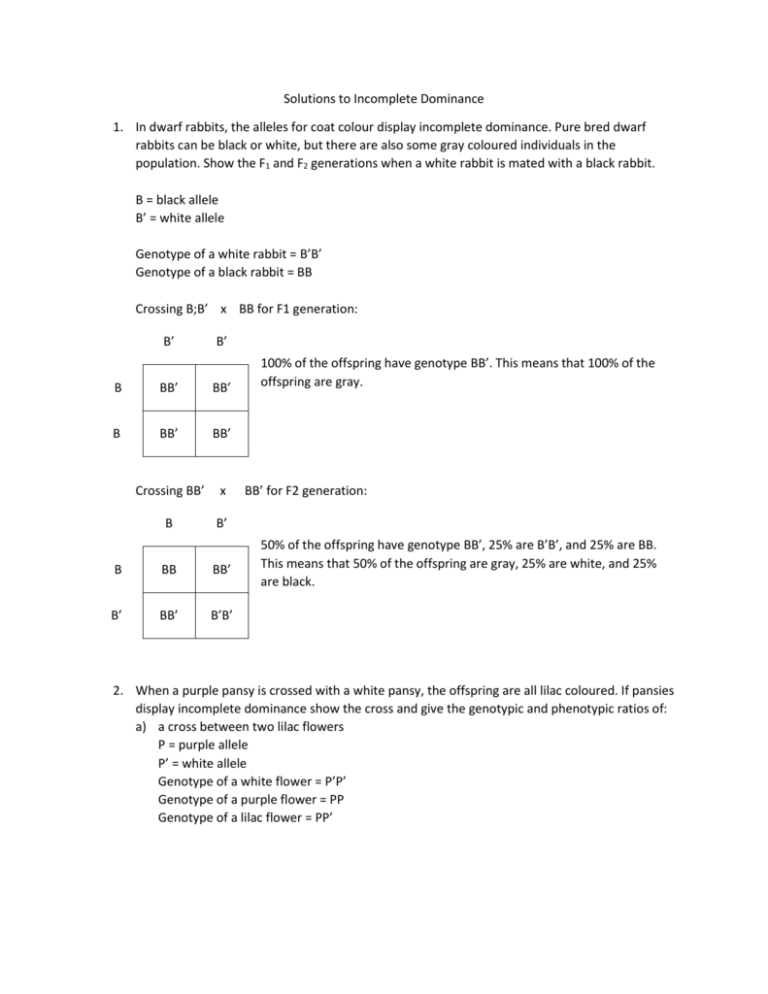
Solutions to Incomplete Dominance 1. In dwarf rabbits, the alleles for coat colour display incomplete dominance. Pure bred dwarf rabbits can be black or white, but there are also some gray coloured individuals in the population. Show the F1 and F2 generations when a white rabbit is mated with a black rabbit. B = black allele B’ = white allele Genotype of a white rabbit = B’B’ Genotype of a black rabbit = BB Crossing B;B’ x BB for F1 generation: B’ B’ B BB’ BB’ B BB’ BB’ Crossing BB’ x B B’ B BB BB’ B’ BB’ B’B’ 100% of the offspring have genotype BB’. This means that 100% of the offspring are gray. BB’ for F2 generation: 50% of the offspring have genotype BB’, 25% are B’B’, and 25% are BB. This means that 50% of the offspring are gray, 25% are white, and 25% are black. 2. When a purple pansy is crossed with a white pansy, the offspring are all lilac coloured. If pansies display incomplete dominance show the cross and give the genotypic and phenotypic ratios of: a) a cross between two lilac flowers P = purple allele P’ = white allele Genotype of a white flower = P’P’ Genotype of a purple flower = PP Genotype of a lilac flower = PP’ Crossing PP’ x P P’ P PP PP’ P’ PP’ P’P’ PP’: 50% of the offspring have genotype PP’, 25% are P’P’, and 25% are PP. This means that 50% of the offspring are lilac, 25% are white, and 25% are purple. b) a cross between a lilac flower and a purple flower Crossing PP’ x P P’ P PP PP’ P PP PP’ PP: 50% of the offspring have genotype PP’, 50% are PP. This means that 50% of the offspring are lilac and 50% are purple. 3. In horses, the alleles for chestnut colour and white colour exhibit incomplete dominance. a) If a baby horse is a palomino (heterozygous), then what are the possible genotypes and phenotypes of its parents? C = chestnut allele C’ = white allele Genotype of chestnut = CC Genotype of white = C’C’ Genotype of palomino = CC’ Since there is a white allele, both parents cannot be chestnut coloured. Instead, one parent could be chestnut (CC) and one parent could be white (C’C’) OR both parents could be palomino (CC’) OR one parent could be white (C’C’) and one palomino (CC’) OR one could be chestnut (CC)and one palomino (CC’). This is shown in these punnet squares: C’ C’ C CC’ CC’ C CC’ CC’ If one parent is chestnut and one is white, 100% of the offspring are palomino. C C’ C CC CC’ C’ CC’ C’C’ C’ C’ C CC’ CC’ C’ C’C’ C’C’ C C C CC CC C’ CC’ CC’ If both parents are palomino, 50% of the offspring are palomino, 25% are white, and 25% are chestnut. If one parent is white and one is palomino, 50% of the offspring are palomino and 50% are white. If one parent is chestnut and one is palomino, 50% of the offspring are palomino and 50% are chestnut. b) If a baby horse is white, then what are the possible genotypes and phenotypes of its parents? Since the baby is white, neither of the parents can be chestnut coloured. Instead, both parents could be white (C’C’), one parent could be palomino (CC’) and one parent could be white (C’C’) OR both parents could be palomino (C’C’). This is shown in these punnet squares: C’ C’ C’ C’ C’ C’ C’ C’ C’ C’ If both parents are white, 100% of the offspring are white. C C’ C’ C C’ C’ C’ C’ C C’ C’ C’ C C’ C CC CC’ C’ CC’ C’ C’ If one parents is white and one is palomino, 50% of the offspring are palomino and 50% are white If both parents are palomino, 50% of the offspring are palomino, 25% are white, and 25% are chestnut. 4. A heterozygous blood type A man and an AB type woman have a child. What is the probability that the child will be type B? Blood type A allele = IA Blood type B allele = IB Blood type O allele = O Heterozygous blood type A genotype = IAi Type AB genotype = IAIB Crossing IA i x IA IB IA IA IA IA IB i IA i IB i IAIB The genotypes are 25% IA IA, IA IB, IAi, and IBi. The probability that the child will be blood type B is 25%. 5. A homozygous blood type A man and a heterozygous blood type B woman have 12 children. How many children will have blood type b? Blood type A? Blood type A allele = IA Blood type B allele = IB Blood type O allele = O Homozygous blood type A genotype = IAIA Heterozygous blood type B genotype = IBi Crossing IB i x IA IA IB IA IB IA IB i IA i IA i IAIA The genotypes are 50% IA IB, and 50% IAi. The probability that the children will be blood type B is 0% and the probability that the children will be blood type A is 50%. Therefore, 0 out of 12 children will be blood type B and 6 out of 12 children will be blood type A. 6. A man with blood type O and his wife (blood type unknown) have 2 children. a) If one of the children has blood type A and one of them has blood type B, what must the mother’s genotype be? Blood type A allele = IA Blood type B allele = IB Blood type O allele = O Blood type O genotype = ii Since the father is blood type O, each child will always inherit a i allele from him. If one child has blood type A and another has blood type B, this means the children must have inherited the A and B alleles from the mother. Therefore, the mother must have both the A and B alleles. Therefore, the mother must have blood type AB and her genotype must be IAIB. b) If one of the children has blood type A and the other has blood type O, what must the mother’s genotype be? Since the father is blood type O, each child will always inherit a i allele from him. If one child has blood type A and another has blood type O, this means the children must have inherited the A and extra O alleles from the mother. Therefore, the mother must have both the A and O alleles. Therefore, the mother must be heterozygous for blood type A and have a genotype of IAi.

